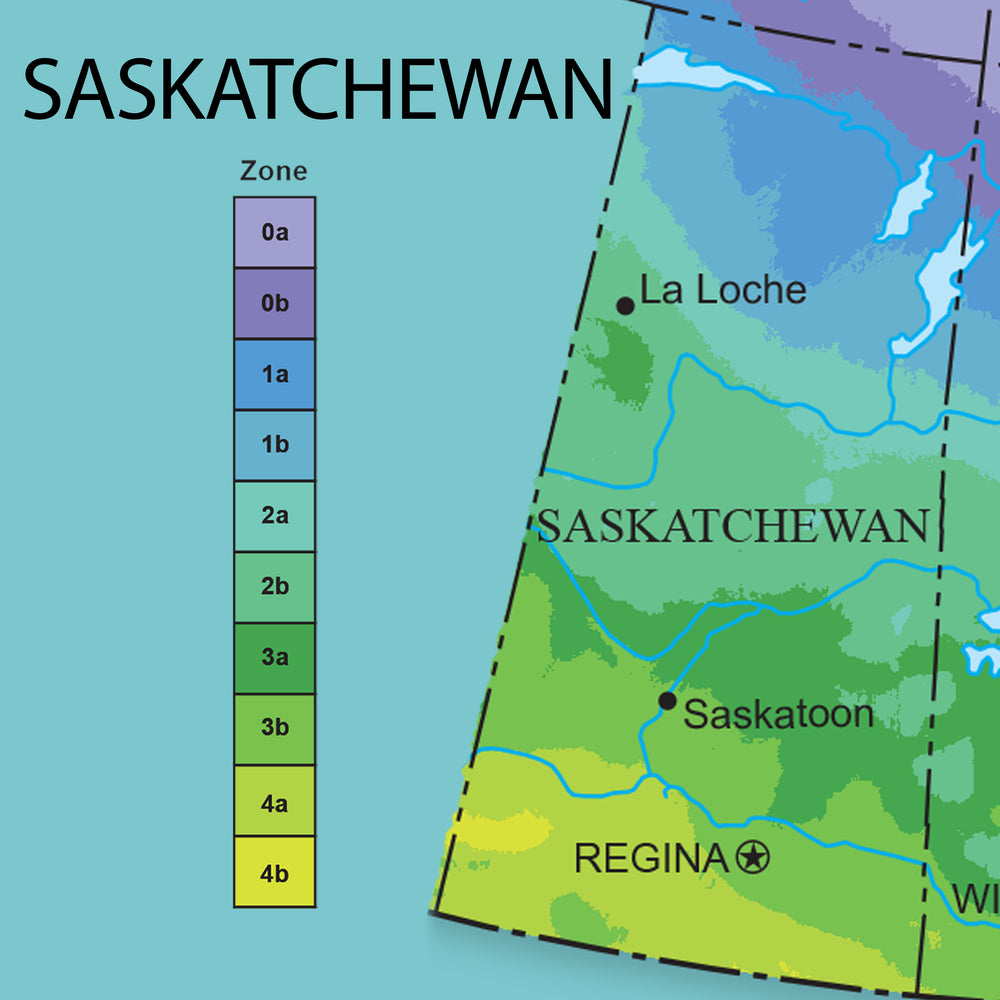Image from Natural Resources Canada
Characteristics of Saskatchewan Planting Region
Saskatchewan has a continental climate and experiences more sunshine throughout the year than most Canadian provinces. However, the weather is diverse and challenging, and the region is known to have one of the most variable climates in the world. Extreme weather events are not uncommon, and the province can experience drastic temperature changes, droughts, thunderstorms, blizzards, and tornadoes.
The province can be divided into three distinct climate regions:
1. Northern Saskatchewan
This region experiences a subarctic climate with short cool summers and long, frigid winters.

2. Central and Eastern Saskatchewan
The central area of the province has a humid continental climate characterized by warm to hot summers and cold winters with moderate snowfall.

Image from Natural Resources Canada
3. Southwestern Saskatchewan
The lower part of the region experiences a semi-arid climate. The conditions are warmer and drier throughout the year, with longer summers and milder winters.

Image from Natural Resources Canada
The growing season is relatively short in Saskatchewan. On average, the frost-free period will begin towards the end of May and end around mid-September. However, this will vary across the region, so it’s best to check the frost-free dates for your specific location.
Challenges of Growing in Saskatchewan
1. Short growing season
The limited growing time frame means that many plants will be unable to reach full maturity before the frost-free season is over. A combination of indoor growing and outdoor growing may be necessary to maximize your planting season.
2. Extreme weather
Extreme and unpredictable weather events in this region make growing a successful garden in Saskatchewan quite challenging. Protective coverings or indoor gardening may be necessary to keep your plants out of harm’s way.
3. Temperature changes
Even the hardiest plants may struggle to survive through the drastic temperature changes in this region. Indoor growing is suggested to help regulate growing temperatures and ensure your garden thrives.

Indian Head, Saskatchewan, Canada | Photo by Dan Loran on Unsplash
The Benefits of Using a Greenhouse in Saskatchewan
There are several key benefits to using a greenhouse for your garden in Saskatchewan. It will provide protection from temperamental weather, regulate temperatures indoors, and harness the power of the sun in this region to help extend your growing season well beyond the summer months.
1. Extend your Growing Season
-
Without a Greenhouse:
Gardeners can expect a limited growing season of 2-4 months across the province of Saskatchewan. Early frosts and a colder climate mean many gardeners will struggle to find ways to extend this season without some form of indoor growing.
-
With a Greenhouse:
Extend your planting season by several months with a greenhouse. Enjoy up to 7-9 months of extended growing season versus the shorter planting timeframe in Saskatchewan. A greenhouse will work wonderfully in this region, allowing you to grow and harvest delicious vegetables well into the cold winter months.
Learn more about specific growing dates for your area and the best vegetables to plant in each part of Saskatchewan.


Customer images of the Sungrow greenhouse in similar climates within Canada | left: Athabasca, Alberta, right: Thunder Bay, Ontario
2. Grow a Wider Variety of Vegetables
-
Without a Greenhouse:
Outdoor gardeners are very limited in their planting options, regardless of the time of year. While the following cold-hardy vegetables grow well across the province, further north, you may have to use indoor growing and transplant these vegetables at a later date.
- Cabbage
- Kale
- Lettuce
- Radishes
- Broccoli
- Peas
- Turnips
-
Beets
-
With a Greenhouse:
Despite the short growing season and cold weather in Saskatchewan, greenhouse gardeners can enjoy a variety of tasty vegetable options. Push the limits of a planting season with some of the following plants:
- Celery
- Leeks
- Spanish Onions
- Brussel Sprouts
- Basil
- Cucumber
- Eggplant
- Sweet Onions
- Okra
- Peppers
- Pumpkins
- Squash
- Tomatillos
- Melons
- Tomatoes
- Carrots
- Watermelon
- Cantaloupe
- Corn
- Gourds
- Cowpeas
 Raised garden beds | Photo by Jonathan Kemper on Unsplash
Raised garden beds | Photo by Jonathan Kemper on Unsplash
Why Planta Greenhouses?
- Wind resistant up to 65 mph (learn more about how our greenhouses hold up in high-altitude climates).
- Withstands a snow load of up to 98 psf (480kg/square meter).
- Made with a heavy-duty galvanized steel frame.
- Polycarbonate panels provide 100% protection against UV rays.
- The Sungrow greenhouse is bell-shaped - allows the wind, snow, and hail to slide off the sides.
- Extendable (Sungrow, Sigma and Farmer models can be extended beyond 100ft)
- Made in Europe and are exclusively imported
- Maintenance-free

